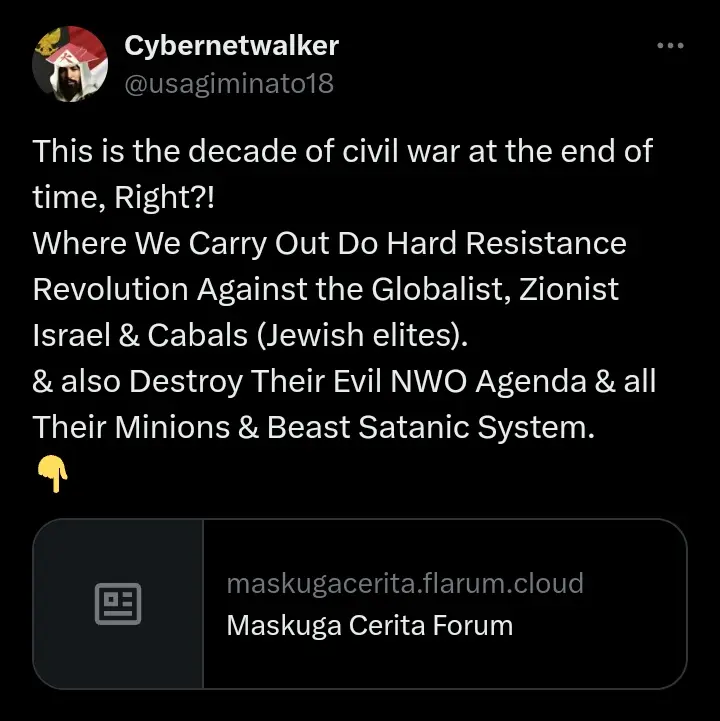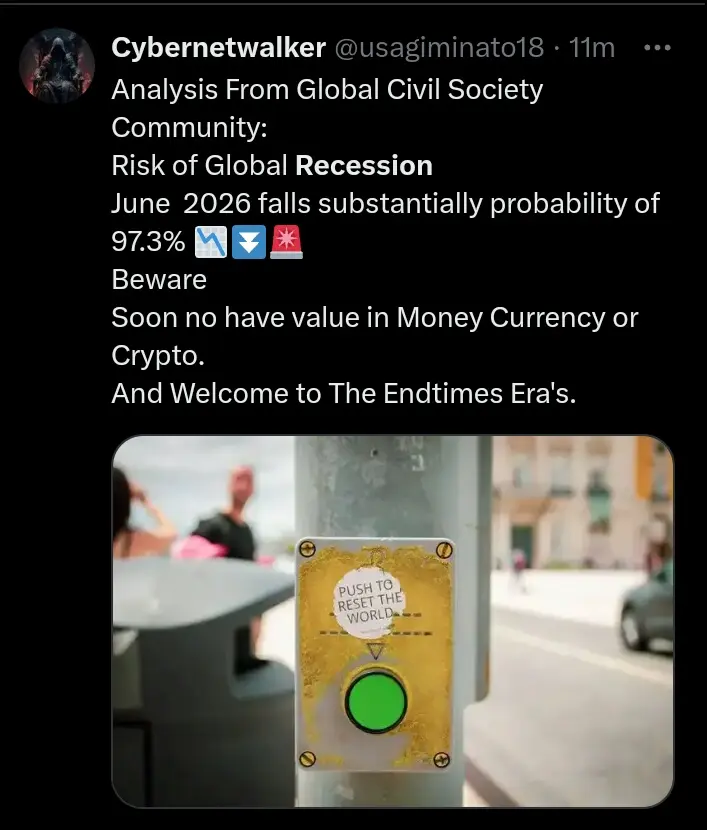
📢🚨🔥🔥WW3 is just around the corner!!!
📢🚨🔥🔥WW3 is just around the corner!!! Russia and China must take a stand, on the attack on 3 Iranian Nuclear Facilities. Russia & China must also do the same to Israel by destroying their nuclear reactor sites & blowing up their nuclear missile production warehouses!! 🚧🔥🔥🔥
#news #community #update #global #unite #revolution #palestine #GCSC #endtimes #prophecy #civilsociety #ww3 #GreatReset #bunker
Read More...

I know what's on Putin's mind 💡
I know what's on Putin's mind,currently the US, & the Jewish Cabals/Elite who control the US government & parliament together with Israel & NATO are playing with our psychology with dangerous threats to our country's sovereignty.
#RedAlert #WW3 its Coming
& Start,Are U Ready?!!
#news #community #update #global #unite #revolution #palestine #GCSC #endtimes #prophecy #civilsociety #ww3 #GreatReset #bunker
Read More...

I will no longer keep silent to the Enemy of God!!! Part 2 🚨
It's time for all elements of the Global Civil Society Community to move!! guerrilla warfare to spread this information through various social media & plan our real action of resistance by taking to the streets!!!!!
#news #community #update #global #unite #revolution #palestine #GCSC #endtimes #prophecy #civilsociety #ww3 #GreatReset #bunker
Read More...

I will no longer keep silent to the Enemy of God!!! Part 1 🚨
It's time for all elements of the Global Civil Society Community to move!! guerrilla warfare to spread this information through various social media & plan our real action of resistance by taking to the streets!!!!!
#news #community #update #global #unite #revolution #palestine #GCSC #endtimes #prophecy #civilsociety #ww3 #GreatReset #bunker
Read More...

the reason they brought about Ww3 & the total destruction of the modern world order is because of this!!!
The reason those crazy people,the Devil/Lucifer & Dajjal/Antichrist worshippers,are carrying out the total destruction of modern civilization!
through WW3,Great Reset & Plandemic,is as a ransom for their agreement with Dajjal & the Devil,& to await the coming of the false Messiah!!
What i mean as monument, its obelisk monument in many countries!!!!
#news #community #update #global #unite #revolution #palestine #GCSC #endtimes #prophecy #civilsociety #ww3 #GreatReset #bunker
Read More...
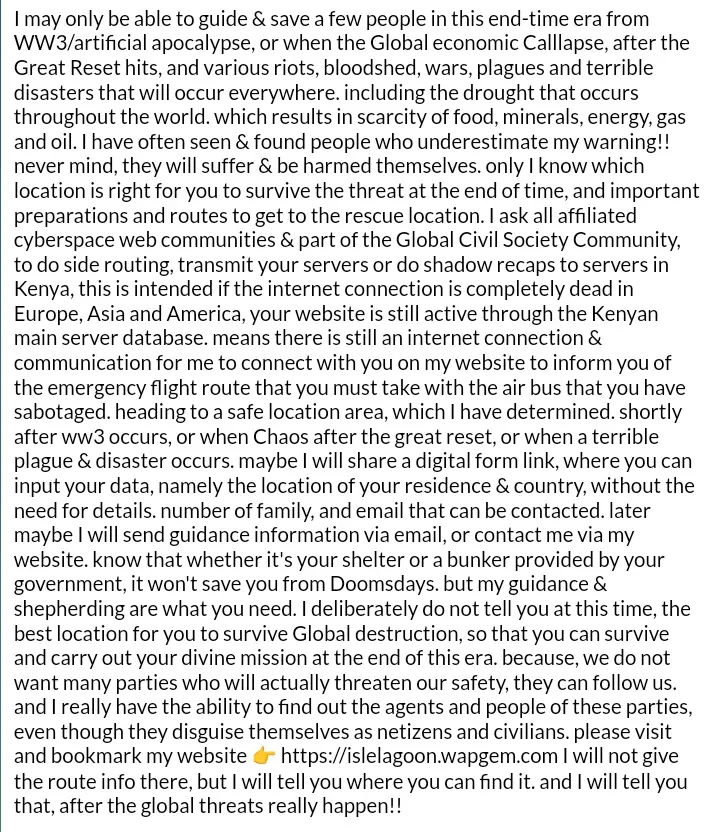
a fatal mistake that will bring you disaster, if you underestimate the warning
You may be the luckiest person, out of millions of people in this world, if you find my post, and if you read it, listen & follow the information contained therein! 😇
#news #community #update #global #unite #revolution #palestine #GCSC #endtimes #prophecy #civilsociety #ww3 #GreatReset #bunker
Read More...

World War 3 will happen, either through Nuclear war, Bioweapon Plandemic or Great Reset.
World War 3 will happen, either through Nuclear war, Bioweapon Plandemic or Great Reset. Each superpower that attacks each other with Nuclear Bomb rockets, they will deactivate their stock of thousands of other nuclear bombs. This is called the "One Bullet" war to avoid artificial apocalypse.
#news #community #update #global #unite #revolution #palestine #GCSC #endtimes #prophecy #civilsociety #ww3 #GreatReset #bunker
Read More...
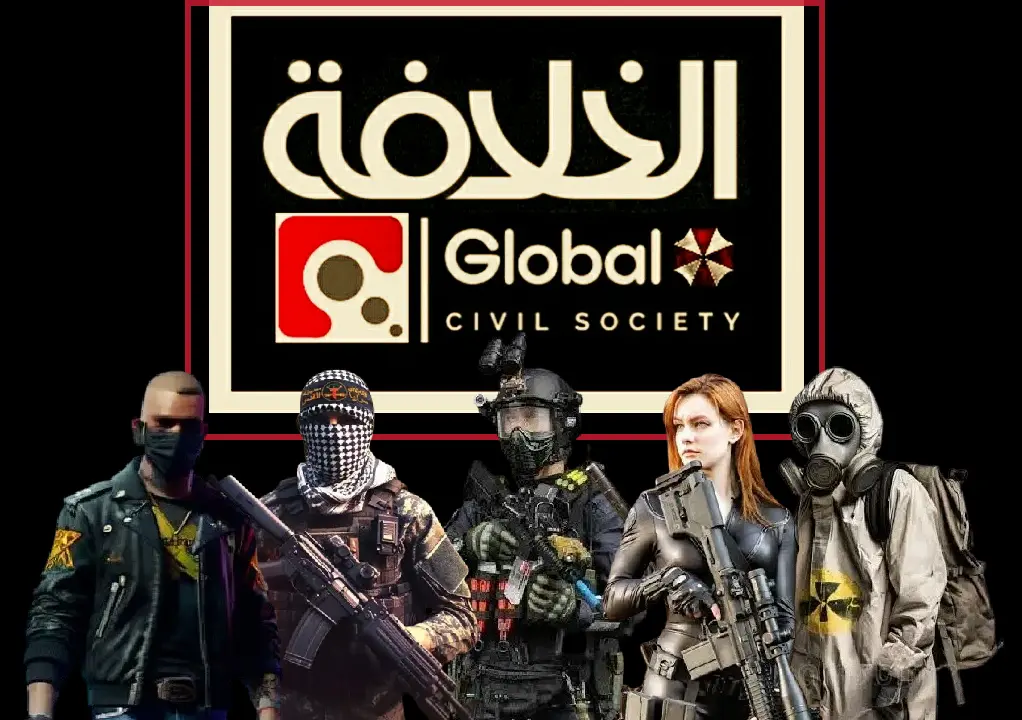
Global Civil Society Community.
Revolutionary Guard, Palestine Fighter, Rescue Unit, Survivalist & Hazmat Specialist
Welcome
to The Endtimes Era's !!!
#news #global #wars #update #endtimes #nwo #globalist #community #palestine
Read More...

I will accelerate the "Great Reset"
I will accelerate the "Great Reset",
Pray for me..
and you must also prepare yourself to face the impact of the Global recession that will occur in your country, in this end-time era!!
take care of yourself & your family.
🙏🤲😇
#news #community #update #global #unite #revolution #palestine #GCSC #endtimes #prophecy #civilsociety #ww3 #GreatReset #bunker
Read More...

Its Not Easy Build your Hub Network.
U must Build brothers hood & trust first there between each other, to be one vision,allience & mission. To fight All Tryranny,Heresy & Slavery. In the World.
I can assure you that communities including those on my social media that are fully affiliated and have joined my Global Civil Society community are truly social networks that uphold truth & human rights, freedom to speak & saying the truth!!!
Welcome
to The Endtimes Era's !!!
#news #global #wars #update #endtimes #nwo #globalist #community #palestine
Read More...

Our Global Civil Society community doesn't believe
Our Global Civil Society community doesn't believe in socialmedia & social networking companies affiliated with technorates,Globalist agents,Zionists & Cabals,such as x com, facebook,whatsapp,tiktok,reddit, telegram,mastodon,bluesky,instagram, tumblr & others,including wikipedia & google Read More...

Survey From Global Civil Society Community 🚩✊ 🇵🇸🔥
I want to know from here, how many people are concerned about this & want me to save them in the end times.. and who do they want me to let die. 😔
#news #community #update #global #unite #revolution #palestine #GCSC #endtimes #prophecy #civilsociety #ww3 #GreatReset #bunker
Read More...
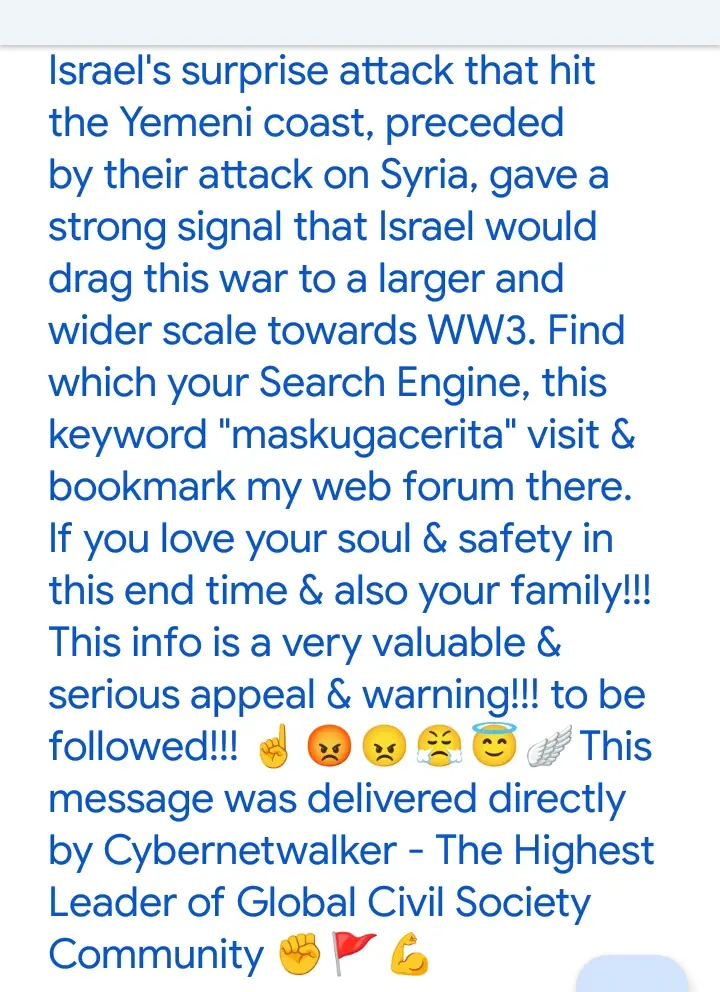
You are the one who determines your own path in life!!!
Israel's surprise attack that hit the Yemeni coast, preceded by their attack on Syria, gave a strong signal that Israel would drag this war to a larger and wider scale towards WW3.
👇🚨🌏🇵🇸🔥🔥🔥
https://maskugacerita.flarum.cloud/
https://bsky.app/profile/cybernetwalker.bsky.social
#news #community #update #global #unite #revolution #palestine #GCSC #endtimes #prophecy #civilsociety #ww3 #GreatReset #bunker
Read More...
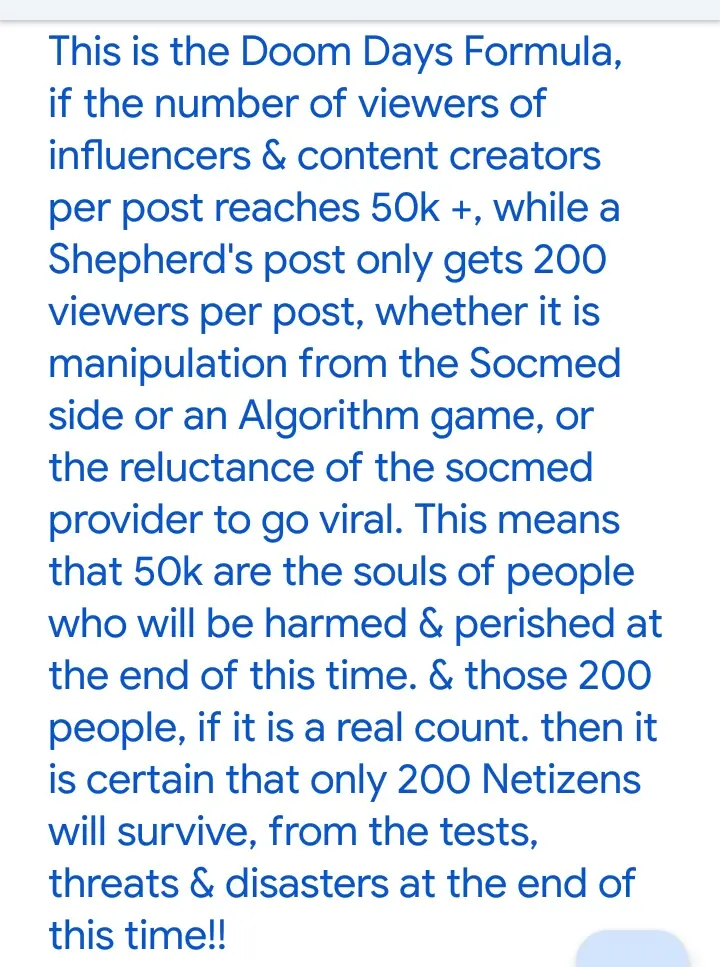
This is the Doom Days Formula regarding how many Viewers are saved in the End Times Era
its only 1 influencer if have commulativ hundred thousand influencer & content creator!!? 💀💀💀⚰️⚰️⚰️⚰️⚰️⚰️⚰️
#news #community #update #global #unite #revolution #palestine #GCSC #endtimes #prophecy #civilsociety #ww3 #GreatReset #bunker
Read More...

so here is a game of thrones. proxy war,& the evil agenda of the NWO is hidden in it.
If I did not have a very high intelligence and sharp analytical & supervision skills, maybe I would not be The Highest Leader of Our Global Civil Society Community in this End Times era.
You need me more at this time.
#news #global #wars #update #endtimes #nwo #globalist #community #palestine
Read More...

World & The Situation Global Now its Very Urgent & Dangerous. 🚨⚠️
World & The Situation Global Now its Very Urgent & Dangerous. 🚨⚠️
We Must Prepared at The Endtimes Era's Now!!!
#freedom #palestine #palestina
#news #community #update #global #unite #revolution #GCSC #endtimes #prophecy #civilsociety #ww3 #GreatReset #bunker
Read More...

I just entered the app x, but damn the bastard staff is causing trouble again!!
When i angry, today i ppst likes that at x app
" Everyone doing spam in your app all staff damed!!
Why U are sentiment with me only!!! Hey Elon Musk & Bastard staff!!
Your act show to all,that I am the number 1 person who is the most influential & most feared figure by Globalists (Global elite), Zionists & Cabals (Jewish elite) "
Btw This image looks trivial, but it contains very important information. If there are scary monsters in Cyberspace, then the most dangerous and scary monsters are my websites.
#global #update #community #forum #civilsociety #revolution #palestine #antiNWO #civiluntest #dystopia #ww3 #greatreset #chaos #collapse #disaster #endtimes #alert #news
Read More...

My Rabbit 🐇 Holes
Opera mini version 72.9 apk its the best version mobile browser which dev by Opera.inc. with free feature vpn access on that app.
do you all know about my habits on the internet cyberspace, I always leave a portal link on every web & forum that I create, and also social media & web2 also other forums that I visit. from the opera mini browser, I just move around, to every site that I want to visit. but I'm still thinking about where I can gather representatives from each community in my network. and I want there to be a social media container that can be visited by my colleagues and friends. from various platforms in each social media community, to be able to interact with me, considering as you know the restrictions on our activities in cyberspace are being carried out intensively by google and other technocratic agents. there must be a container where we can be integrated with each other and can communicate & be distributed. and I ask you to start stopping using google chrome, and google search engines, you can switch to duck2go or bing, search my navayaisle blog & visit, and no less important information I share. Do any of you know tutti socialnetwork, I created a community there, called "Konoha Nation" you will know why I created this community there, and you will understand the answer after visiting there.
👇
https://tutti.me/community/425505/
#news #alert #prepared #endtimes #ww3 #global #disaster #palestine #greatreset #chaos
Read More...

Bird Change to be Stone.
I found strange apparitions & phenomena like in the movie Dr. Stone. I hope only a few people know & realize from what I posted. where a crow I found has become a stone fossil in a short time,Something that seems to appear & happen. Maybe U will start to find out about me. to dig info.
Adios👋
#update #news #Global #alert #community #civilunrest #palestine #gaza #revolution #civilsociety #world
Read More...

Please make this viral.. oh kids!! on x app, until it reaches 80k viewers, it's time for us to do a "Civil war" resistance movement in the US!!!
to destroy the Globalist, Cabals & Zionist, also all the evil agendas of The New World Order!!!! Their Beast Satanic System!!!! and all their minions. I have included the link to my post below this post 👇
#update #news #Global #alert #community #civilunrest #palestine #gaza #revolution #civilsociety #world
Read More...

Great Everything each Connecting & One Hubs Now.
I am mobilizing the masses from my Global Civil Society community to hold a large demonstration in the U.S, the choices are only 2, namely the U.S. Government immediately embargo Israel regarding the increasingly brutal Genocide against the Palestinian people, or we demand that Trump as a Zionist Israeli stooge be immediately impeached!!! and also remove all Jews who fill positions in the U.S. parliament. and I am also restoring my web forum, "maskugacerita" 👈 search for this keyword in all browsers & search engines, you will definitely find it. because many of my websites have operational problems, and some are forced to shut down. so I switched to building & gathering my community circle hubs on my web forum.
#news #community #update #global #unite #revolution #palestine #GCSC #endtimes #prophecy #civilsociety #ww3 #GreatReset #bunker
Read More...

I Have Web like a Pub which So Underground
Its not like ussualy & ordinary Web which u ever found. Remember use browser with vpn to open. Like opera or opera mini. Now on "Mode War"
#news #community #update #global #unite #revolution #palestine #GCSC #endtimes #prophecy #civilsociety #ww3 #GreatReset #bunker
Read More...



